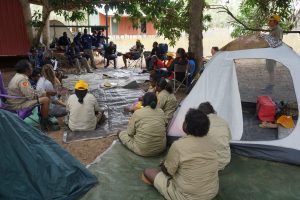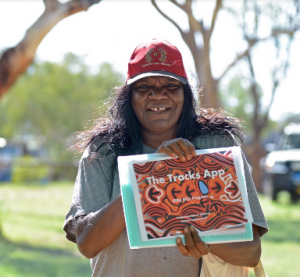The Atlas of Living Australia (ALA) is currently partnering with Indigenous communities across Australia to develop a new Indigenous Ecological Knowledge (IEK) platform on the ALA.
The new platform aims to bring together Indigenous and non-Indigenous biodiversity knowledge in the one place to afford recognition to the unique and extensive Indigenous-held biodiversity knowledge that exists across Australia.
IEK is current employed by Indigenous land and sea managers to manage Australia’s biodiversity, although this is not well known. It is intended that the new knowledge platform will provide an avenue through which we can more accurately assess where there are gaps in our combined knowledge systems, as well as increase understanding of the contribution that IEK can and does make to the management of Australia’s biodiversity.
To celebrate the theme for this year’s NAIDOC week – Because of Her, We Can! – we have included three stories that highlight the IEK work undertaken in the ALA, and which have Indigenous women as the driving force.
Cherry Daniels, cultural adviser for the east Arnhem Land work
Cherry Wulumirr Daniels OAM, other Elders, Rangers and young people of the SE Arnhem Land and Laynhapuy Indigenous Protected Areas in eastern Arnhem Land are working with Emilie Ens and Ben Kitchener, ecologists from Macquarie University, to document species and share traditional Aboriginal names and stories of plants and animals with other Australians.

Under Cherry’s guidance, Ngukurr community from SE Arnhem Land have been working on a cross-cultural field guide of 275 plant and animal species that includes Western and local Indigenous scientific knowledge. They are currently transforming this book into an online version through a private webpage of the ALA that can be used by community members and the local schools to learn more about local species, cultural knowledge and threats. The team is also providing a two-way Indigenous engagement case study to encourage more Indigenous content and, importantly, feedback loops to make the ALA more relevant and useful for Indigenous people.
Cherry has guided this project and its evolution over 10 years. Cherry is a 73 year old Ngandi woman who lives in Ngukurr community in the NT. She works tirelessly to inspire all people, especially young people and women in her community, to care for their country, culture and languages. Her strong knowledge of how the land was prior to recent threats from invasive species, wildfire and climate change, combined with her rare cultural knowledge make her a treasure of not only her community but all of Australia, as recognised by an OAM in 2016. As part of her work, she has mentored many other Aboriginal women to fill her large shoes, including women from the Yugul Mangi Rangers, Julie Roy, Edna Nelson and Maritza Roberts, as well as young people from the Ngukurr Yangabla (Young People) Project, including Karis Robertson, Sandra Blitner and Melissa Wurramarrba. Melissa was a finalist in the NT Young Achievers Awards 2018 and is currently studying at Macquarie University in Sydney, alongside Cherry’s grandson Ernest Junya Daniels.

For more information on Cherry read Way of the water lilies: Where science meets the billabong
Development of the seasonal calendar platform
Emma Woodward (CSIRO/ALA) is working with traditional owners from three regions of Australia to develop and test an interactive seasonal calendar platform. Indigenous women are driving each of these research engagements.
The Far West Coast Aboriginal Corporation Women’s Group, with guiding support from Cecilia Cox and Tammy Cox, are working to develop a seasonal wheel for their region. The content of the seasonal wheel includes detailed local understanding of seasons, their influence on, and relationship to biodiversity and biodiversity management. Traditional owners from Oak Valley, Yalata, Scotdesco, Koonibba and Ceduna in South Australia are all contributing to its development. The fieldwork and process of knowledge collation is in turn informing the development of the digital seasonal calendar platform, and will be one of the first calendars uploaded into the platform. The ALA is also working with Martu Elders through the Wiluna Remote Community School, supported by the CSIRO Science Pathways program, and with Gulumoerrgin (Larrakia) traditional owners from the Darwin region, Northern Territory.
The development of the digital seasonal calendar platform has been informed by previous work driven by Gulumoerrgin (Larrakia) traditional owner Lorraine Williams. You can view the interactive online seasonal calendar here: http://www.larrakia.csiro.au/#/calendar/dinidjanggama
Josephine Grant, ranger coordinator from the Central Land Council, and adviser on The Tracks App project
The Tracks App is a data collection system designed to be used by Aboriginal rangers to record animal signs, such as tracks, scats, diggings and burrows, identified using traditional tracking techniques.

Funded by the Australian Government, the Tracks App was designed by Central Land Council staff and developed with the ALA as part of the Bilby Blitz program. The Bilby Blitz aimed to survey the Greater Bilby across Aboriginal managed land across the Northern Territory and Western Australia.
As coordinator of the Anmatyerr Ranger group and expert tracker in her own right, Josephine Grant provided significant input into the app’s development. She has since used it in the field to record bilby signs and with school students to increase their understanding and awareness of tracking work.
A major aim of the Tracks App was to make it available in Aboriginal languages as English is often a second, third or fourth language for Aboriginal people. In March 2018 the CLC launched English and Warlpiri language versions of the app. Josephine has been working with Gladys Brown, lead ranger from the Muru-Warinyi Ankkul Ranger Group in Tennant Creek, on translating it into the Waramungu language.
The ALA are also working with a number of different communities across Australia including Ngukurr and Laynhapuy Homelands communities in eastern Arnhem Land, Northern Territory (NT), the Olkola People of Cape York, Banbai nation people in northern New South Wales, nine regions represented by the Central Land Council in the southern half of the Northern Territory, and the Larrakia people in the Darwin region of the Northern Territory.
For more information about this year’s NAIDOC week that was from the 8-15th of July, visit NAIDOC Week 2018 https://www.naidoc.org.au/get-involved/2018-theme